
Beginning in 2004, accounts of physical, psychological, and sexual abuse, including torture, rape, sodomy, and homicide of prisoners held in the Abu Ghraib prison in Iraq (also known as Baghdad Correctional Facility) came to public attention. These acts were committed by personnel of the 372nd Military Police Company of the United States Army together with additional US governmental agencies.
An Afghan Refugee Child Hides From a Dust Storm:
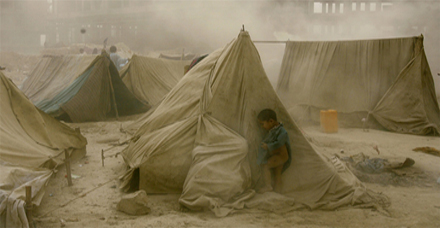
Bhopal India – Methyl Isocyanate Spill:
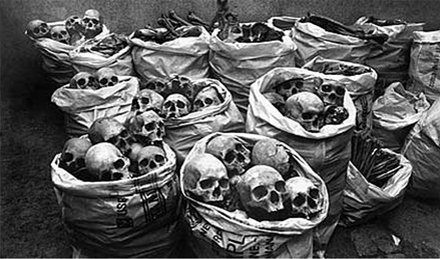
More than 40 tons of methyl isocyanate spilled from a Union Carbide-owned pesticide factory in Bhopal, India, in 1984, killing more than 20,000 people in the world’s worst chemical disaster.
After the spill, these skulls were researched, presumably for the specific effects the gas had on the brain, at the nearby Hamidia Hospital. The chemical injured not only the people who inhaled it, but also nearby animals (at least 2,000 of them) and trees, whose leaves went yellow and fell off within days.
Twenty-five years later, with people still claiming injury from the disaster yet little corrective action having been taken, the government of India has called for a study into the long-term effects of the spill.
Biafra:
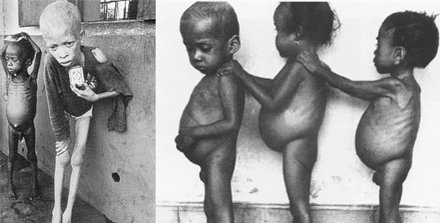
When the Igbos of eastern Nigeria declared themselves independent in 1967, Nigeria blockaded their fledgling country-Biafra. In three years of war, more than one million people died, mainly of hunger. In famine, children who lack protein often get the disease kwashiorkor, which causes their muscles to waste away and their bellies to protrude.
Boston Fire:

On July 22, 1975, Stanley J. Forman was working in the newsroom of the Boston Herald American newspaper when a police scanner picked up an emergency: “Fire on Marlborough Street!” Forman rushed to the scene, where multiple fire crews were battling an intense blaze. There was a distress call for a ladder team to the rear of the building to help a stranded woman and child. Forman followed.
Buchenwald Camp:
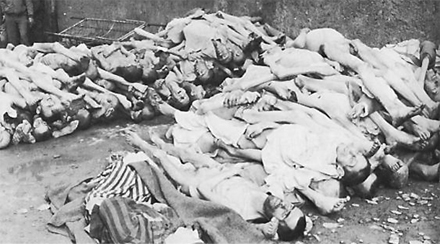
In 1937, the Nazis constructed Buchenwald concentration camp, near Weimar, Germany. Placed over the camp’s main entrance gate, was the slogan Jedem das Seine (literally “to each his own”, but figuratively “everyone gets what he deserves”). The Nazis used Buchenwald until the camp’s liberation in 1945. From 1945 to 1950, the Soviet Union used the occupied camp as an NKVD special camp for Nazis and other Germans. On 6 January 1950, the Soviets handed over Buchenwald to the East German Ministry of Internal Affairs.
The SS left behind accounts of the number of prisoners and people coming to and leaving the camp, categorizing those leaving them by release, transfer, or death. These accounts are one of the sources of estimates for the number of deaths in Buchenwald. According to SS documents, 33,462 died in Buchenwald. These documents were not, however, necessarily accurate: Among those executed before 1944 many were listed as “transferred to the Gestapo”. Furthermore, from 1941 forward Soviet POWs were executed in mass killings. Arriving prisoners selected for execution were not entered into the camp register and therefore were not among the 33,462 dead listed in SS documents.
Burial Of an Unknown Child:
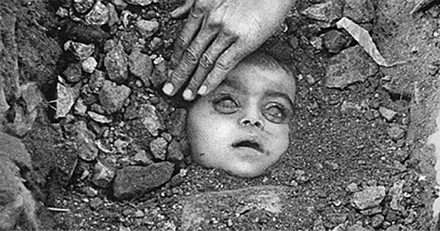
Burial of an unknown child. This picture shows the world’s worst industrial disaster, caused by the US multinational chemical company, Union Carbide.
Burning Monk:
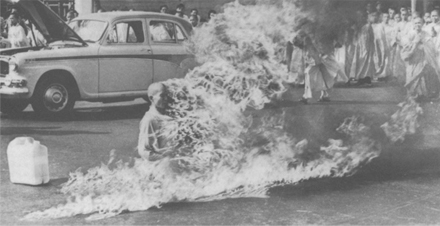
As a protest to the This Monk slow and unreliable reforms in Vietnam, the Buddhist monks have resorted to immolation, such as this Mahayana Buddhist monk, He burned himself alive across the outskirts of Saigon, mainly because of the harshness done by the South Vietnam government to his fellow Buddhist monks.
He was re-cremated after he burned himself; his heart meanwhile remained in one piece, and because of this he was regarded as a Bodhisattva by the other Buddhist monks and followers. His act of self-immolation increased the pressure on the Di?m administration to implement their reform laws in South Vietnam.
Bushmeat:

Animals from primates to snakes are valuable commodities in the thriving, albeit illegal, worldwide trade of bushmeat, defined as wildlife killed either by commercial or subsistence hunters. With one million tons of bushmeat taken from African forests every year, the already endangered gorilla population-a primary victim of the trade-is in dire straits.
This photo shows a gorilla family in southeast Cameroon (minus the alpha male silverback, who managed to get away) that had been slaughtered in their nests by a bushmeat hunter early one morning.
Execution Of a Viet Cong Guerrilla:
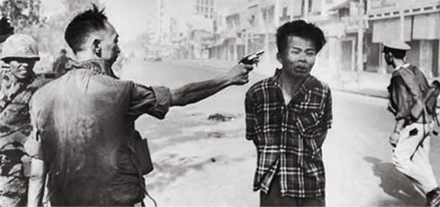
This picture was shot by Eddie Adams who won the Pulitzer prize with it. The picture shows Nguyen Ngoc Loan, South Vietnam’s national police chief executing a prisoner who was said to be a Viet Cong captain. Once again the public opinion was turned against the war.
Hector Pieterson:

Hector Pieterson an icon of 1976 Soweto uprising in apartheid South Africa. Dying Hector being carried by a fellow student. He was killed at the age of 12 when the police opened fire on protesting students. For years, June 16 stood as a symbol of resistance to the brutality of the apartheid government. Today, it is known as National Youth Day – a day on which South Africans honour young people and bring attention to their needs.
Last Jew Of Vinnitsa:
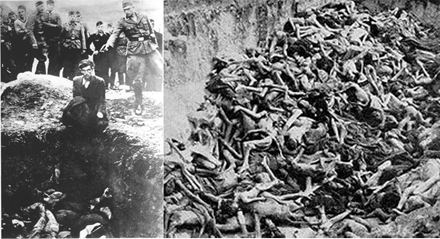
Picture from an Einsatzgruppen soldier’s personal album, labelled on the back as “Last Jew of Vinnitsa, it shows a member of Einsatzgruppe D is just about to shoot a Jewish man kneeling before a filled mass grave in Vinnitsa, Ukraine, in 1941. All 28,000 Jews from Vinnitsa and its surrounding areas were massacred at the time.
Lynching Of Young Blacks:
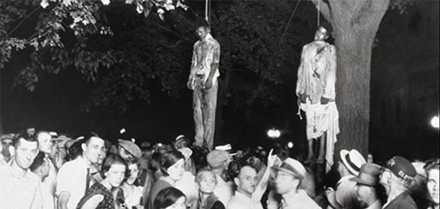
This is a famous picture, taken in 1930, showing the young black men accused of raping a Caucasian woman and killing her boyfriend, hanged by a mob of 10,000 white men. The mob took them by force from the county jail house. Another black man was left behind and ended up being saved from lynching. Even if lynching photos were designed to boost white supremacy, the tortured bodies and grotesquely happy crowds ended up revolting many.
Nagasaki Hiroshima Masroon Clouds:
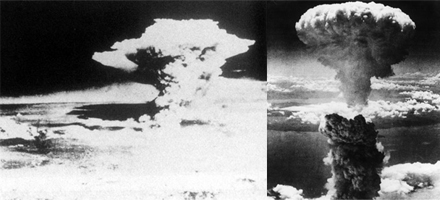
This is the picture of the “mushroom cloud” showing the enormous quantity of energy. The first atomic bomb was released on August 6 in Hiroshima (Japan) and killed about 80,000 people. On August 9 another bomb was released above Nagasaki. The effects of the second bomb were even more devastating – 150,000 people were killed or injured. But the powerful wind, the extremely high temperature and radiation caused enormous long term damage.
Nile Perch in Lake:

One of the 100 most invasive species in the world the Nile perch was introduced to East Africa’s Lake Victoria in the 1950s, and has wreaked environmental havoc ever since. It’s illegal to possess or sell in some parts of the world, and is thought to have caused the extinction or endangering of hundreds of native species in Lake Victoria.
After the fish eliminated much of the algae-eating population, the lake became choked with algae. The perch has also increased local demand for firewood, because their higher fat content drives people to smoke them rather than dry them. Adult perch can grow to weigh more than 440 pounds, and are fierce predators that feed on insects, crustaceans, and other fish-even those of its own species.
Pictured here are dead Nile perch on a butcher table waiting for transport to local markets.
Nilgunyalcin Child Vulture:
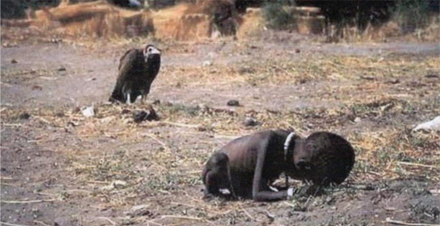
Sudanese child being stalked by a vulture nearby. It is quite obvious that the child was starving to death, while the vulture was patiently waiting for the toddler to die so he can have a good meal.
Nobody knows what happened to the child, who crawled his way to a United Nations food camp. Photographer Kevin Carter won a Pulitzer Prize for this shocking picture, but he eventually committed suicide three months after he took the shot.
Palestine Father Saving Son:
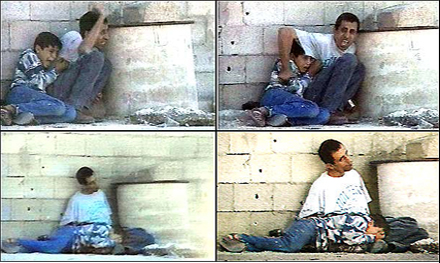
Images from the video footage of 12-year-old Muhammad al-Durrah being shot dead in the Gaza Strip. The scene was filmed by a France 2 cameraman.
Palestinian Refugees:
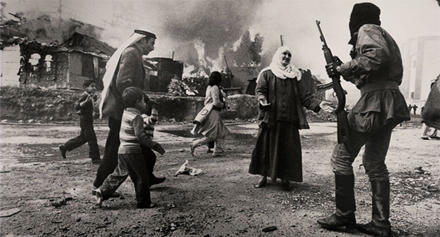
World Press Photo of the Year: 1976 Françoise Demulder, France, Gamma. Beirut, Lebanon, January 1976. Palestinian refugees in the district La Quarantaine. About the image She was the first woman to win the World Press Photo, and did so on the 20th anniversary of the award. Demulder stated at the time that she hated war, but felt compelled to document how it’s always the innocent who suffer, while the powerful get richer and richer.
Palm Oil Deforestation:
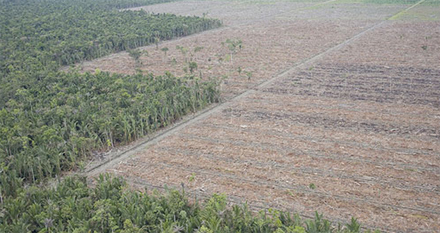
Indonesia is home to the world’s third largest tropical forest, but it’s disappearing quickly. Though often illegal, the forests are cut down both for a booming pulp and paper industry as well as to clear land for oil palm plantations, which supply diverse industries from biofuel to soap to cosmetics.
Because of deforestation, Indonesia is also the world’s third largest greenhouse gas contributor, behind only the U.S. and China; after the forest is cut down, the carbon normally sequestered in the peatland soil is no longer shielded from being released into the atmosphere.
Pollution and Power Lines:

China’s economy has exploded in recent years; so has its pollution problem, leaving no aspect of the country’s environment unaffected. Solid waste often lacks proper disposal, waterways have been polluted, and the air quality has plummeted, largely due to the coal-fired power plants that serve as the country’s primary source of energy.
Environmental degradation has gotten so bad that the Chinese government, which doesn’t easily take-or allow-criticism, has admitted that birth defects in the country have increased as a direct result of it, particularly in coal-producing regions like the north, where this picture was taken.
Second Largest Oil Spill Ever:
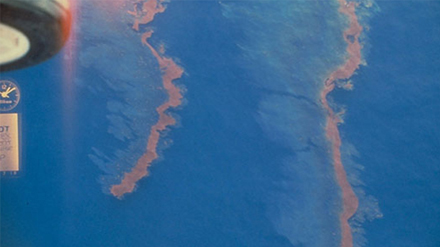
The Ixtoc I exploratory well suffered a blowout on June 3, 1979, in Mexico’s Bay of Campeche, 600 miles south of Texas. The well was not brought under control until the next year, by which time 140 million gallons had spilled into the bay. The only larger spill occurred during the 1991 Gulf War, when Iraq dumped-deliberately-up to 462 million gallons of oil into the Persian Gulf.
Segregated water Fountains:
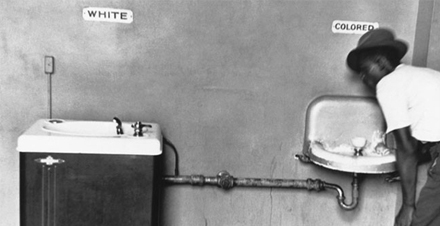
A segregated water fountain with a vastly larger and more desirable fountain for whites, and a small fountain for minorities.
Sludge Kingston Tennessee:
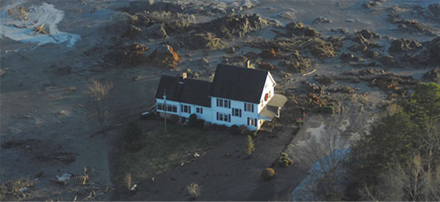
More than 1 billion gallons of toxic sludge were released into a Tennessee community when a dam collapsed last December, causing a massive coal-ash spill at the Kingston Fossil Plant, a coal-burning power plant owned by the Tennessee Valley Authority.
Coal ash is known to contain dangerous elements including arsenic, lead, and selenium, yet the TVA refused at first to issue any health warnings about contamination from the spill. The agency, which weeks later admitted prior leak problems at the plant, also refused initially to declare as uninhabitable the houses in the area, like the one pictured here, that were physically relocated by all the sludge.
Starving Boy:

World Press Photo of the Year: 1980 Mike Wells, United Kingdom. Karamoja district, Uganda, April 1980. Starving boy and a missionary. About the image Wells felt indignant that the same publication that sat on his picture for five months without publishing it, while people were dying, entered it into a competition. He was embarrassed to win as he never entered the competition himself, and was against winning prizes with pictures of people starving to death.
The American Bison:
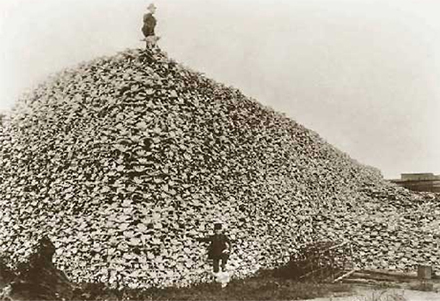
A product of U.S. Army-sanctioned mass slaughter of American bison in the 1800s, these bison skulls are waiting to be ground for fertilizer, most likely in the American midwest. The slaughter was so “effective” that the population of bison in the U.S. is estimated to have dropped from around 60 million in 1800 to as few as 750 in 1890.
Tsunami Dead Bodies:
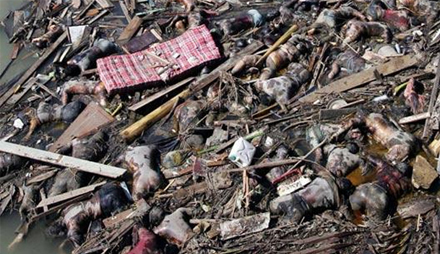
The Boxing Day Tsunami that struck Thailand in 2004 caused approximately 350,000 deaths and many more injuries.
View of Floods:
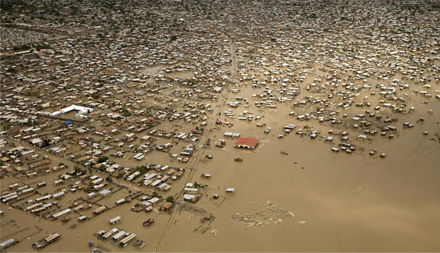
An aerial view of floods caused by Tropical Storm Hanna is seen in Gonaives, Haiti on September 3, 2008. Haiti’s civil protection office said 37 of the 90 Hanna-related deaths had occurred in the port city of Gonaives.


















0 comments: on "Saddest Pictures in the World : Tears keep falling…"
Post a Comment
Don't forget to give your comments about SATC!